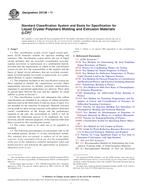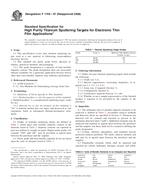Wir benötigen Ihre Einwilligung zur Verwendung der einzelnen Daten, damit Sie unter anderem Informationen zu Ihren Interessen einsehen können. Klicken Sie auf "OK", um Ihre Zustimmung zu erteilen.
ASTM F1844-97(2008)
Standard Practice for Measuring Sheet Resistance of Thin Film Conductors For Flat Panel Display Manufacturing Using a Noncontact Eddy Current Gage
Automatische name übersetzung:
Standard Praxis für Messflächenwiderstand der Dünnfilmleiter für Flat Panel Display Produktion Mit einem Berührungslose Wirbelstrom-Gage
NORM herausgegeben am 15.6.2008
Informationen über die Norm:
Bezeichnung normen: ASTM F1844-97(2008)
Anmerkung: UNGÜLTIG
Ausgabedatum normen: 15.6.2008
SKU: NS-51791
Zahl der Seiten: 5
Gewicht ca.: 15 g (0.03 Pfund)
Land: Amerikanische technische Norm
Kategorie: Technische Normen ASTM
Kategorie - ähnliche Normen:
Die Annotation des Normtextes ASTM F1844-97(2008) :
Keywords:
conductance, electrical conductance, electrical resistance, electrical sheet conductance, electrical sheet resistance, flat panel displays, noncontact eddy current, resistance, sputtered thin films, thin conductive films on glass, thin film, Electrical conductivity, Electrical resistance/resistivity, Electrical sheet resistance, Electronic thin-film applications, Noncontact technique, Sheet resistance, Sputtered thin films, Thin film applications
Ergänzende Informationen
| Significance and Use | ||
|
Resistivity is a primary quantity for characterization and specification of coated glass plates used for flat panel displays. Sheet resistance is also a primary quantity for characterization, specification, and monitoring of thin film fabrication processes. This practice requires no specimen preparation. The eddy current method is non-destructive to the thin film being measured. Special geometrical correction factors, needed for some four-point probe electrical resistivity measurements, are not required to derive the true sheet resistance so long as the transducers have a continuous layer of conductive thin film between them. Test Methods F 673 refers to a testing arrangement in which the transducers and specimen (a semiconductor grade silicon wafer) are rigidly positioned. Similar apparatus is commercially available for testing large glass or plastic substrates, not envisioned in the scope of Test Methods F 673. A hand held probe can also be used, depending on throat depth required. For use as a referee method, the probe and measuring apparatus must first be checked and qualified before use by the procedures of Test Methods F 673 (9.1.1 through 9.1.3 and 9.1.4.2 through 9.1.4.5), then this practice is used. For use as a routine quality assurance method, this practice may be employed with periodic qualifications of probe and measuring apparatus by the procedures of Test Methods F 673 (9.1.1 through 9.1.3 and 9.1.4.2 through 9.1.4.5). The parties to the test must agree upon adequate qualification intervals for the test apparatus. |
||
| 1. Scope | ||
|
1.1 This practice describes methods for measuring the sheet electrical resistance of sputtered thin conductive films deposited on large insulating substrates (glass or plastic), used in making flat panel information displays. 1.2 This practice is intended to be used with Test Methods F 673. This practice pertains to a “manual” measurement procedure in which an operator positions the measuring head on the test specimen and then personally activates the test apparatus. The resulting test data may be tabulated by the operator, or, alternatively, sent to a computer-based data logging system. Both Methods I and II of Test Methods F 673 (paragraphs 3.1 through 3.3.3 of Test Methods F 673) are applicable to this practice. 1.3 Sheet resistivity in the range 0.020 to 3000 Ω per square (sheet conductance in the range 3 by 10–4 to 50 mhos per square) may be measured by this practice. The sheet resistance is assumed to be uniform in the area being probed. Note 1—Typical manual test units, as described in this practice, measure and report in the units “mhos per square”; this is the inverse of “ohms per square.” 1.4 This practice is applicable to flat surfaces only. 1.5 This practice is non-destructive. It may be used on production panels to help assure production uniformity. 1.6 The values stated in SI units are to be regarded as standard. No other units of measurement are included in this standard. 1.7 This standard does not purport to address all of the safety concerns, if any, associated with its use. It is the responsibility of the user of this standard to establish appropriate safety and health practices and determine the applicability of regulatory limitations prior to use. |
||
| 2. Referenced Documents | ||
|
Ähnliche Normen:
Historisch
1.9.2011
Historisch
1.4.2010
Historisch
15.6.2008
Historisch
15.6.2008
Empfehlungen:
Aktualisierung der technischen Normen
Wollen Sie sich sicher sein, dass Sie nur die gültigen technischen Normen verwenden?
Wir bieten Ihnen eine Lösung, die Ihnen eine Monatsübersicht über die Aktualität der von Ihnen angewandten Normen sicher stellt.
Brauchen Sie mehr Informationen? Sehen Sie sich diese Seite an.



 ASTM D5138-11
ASTM D5138-11 ASTM E986-04(2010)..
ASTM E986-04(2010).. ASTM F1709-97(2008)..
ASTM F1709-97(2008).. ASTM F1711-96(2008)..
ASTM F1711-96(2008)..
 Cookies
Cookies
